January 6, 1983
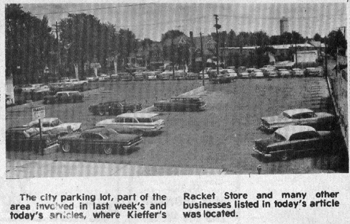
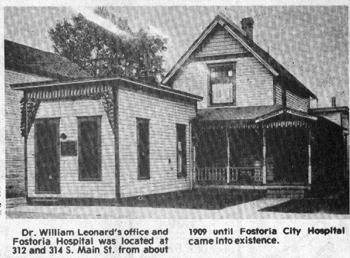
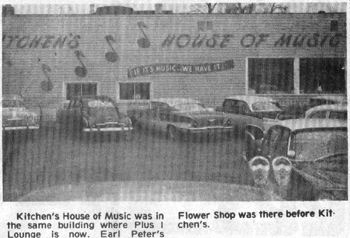
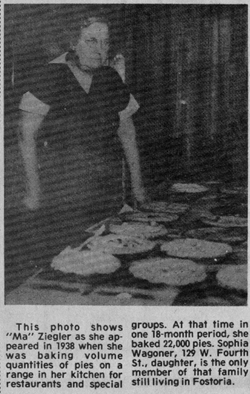
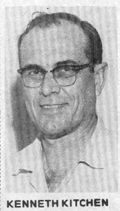
Picture #1 – The city parking lot, part of the area involved in last week’s and today’s articles, where Kieffer’s Racket Store and many other businesses list- in today’s article was located.
Picture #2 – Dr. William Leonard’s office and Fostoria Hospital was located at 312 and 314 S. Main St. from about 1909 until Fostoria City Hospital came into existence.
Picture #3 – Kitchen’s House of Music as in the same building where Plus I Lounge is now. Peter’s Flower Shop was there before Kitchen’s.
Picture #4 – Kenneth Kitchen
Author’s Note: Last week we returned to South Main Street to take another look at the history of business places and people of that era, and in more depth presented the story about Frank Kieffer’s Racket Store. The series continues today.
Space was not available last week to include an important photo, taken in the 1960s which provides an overall view of the area which will be covered in today’s article. In that photo readers can see the city parking lot. Business rooms in frame buildings, similar to the one shown in last week’s article, once existed there. I do not know if there were separate buildings or just one divided into separate rooms.
A “team” of “old timers”–Joe Blaser, a resident of that area for many years; Chet Kieffer, Doris (Kieffer) Clark and your author–have been exchanging opinions about the old buildings and the rooms and I am not sure any of us are positive whether there was one or more buildings and if there were three or four business rooms. The old directories also leave room for doubt. Therefore, I decided to just list the merchants as the directories showed them by years.
Here are the listings for the businesses in the area south of the corner filling stations mentioned last week to the first alley, 1909 through 1938.
No. 304– George H. Hufford, confectionary; Clara B. Kennedy, restaurant; J.C. Fayes, South End Restaurant; Legion Barber Shop; Fred A. Saliers, barber; “Ma” Ziefler’s Restaurant. At the latter restaurant, you could get an excellent lunch for 25 cents and a nice cut of homemade pie for 10 cents.
No. 306–R.S. Blaine Confectionary and Newsstand; Ira Johnson, barber; George B. Baker Restaurant; Frank Jackman, Second Hand Store.
No. 308–Elmer Wagner, plumbing; D.F. Arthur, electrician; Cecil A. Fellers, New & Second Hand Store; Church of God; Clarence P. Werner, restaurant; Aaron J. Peter, sheet metalwork; Holman’s Cafe, Chaney’s Lunchroom.
No. 308 1/2 — Owl’s Hall; George H. Hufford, residence; D.F. Arthur, residence.
No. 310–Kieffer’s New York Bargain Store, later called Kieffer’s Racket Store.
No. 312–Flechtner & Emerine Meat Market; Earl Green Confectionary; Fostoria Produce, G.E. Beigh, proprietor; A&P Team Company; W.H. Weaver and J.H. Mor- ton, photography, phonographs and picture framing.
Between the last business room (No. 312) and the only other building which still exists from the early part of this century, there was a house (No. 314). The one photo shows it with an addition built on the front later. That house is where I was born in 1905 and lived for about three year until the death of my father, George E. Krupp, in 1908. He was a barber by trade and worked in the barbershop in The Hays Hotel.
Sometime after 1908, Dr. William Leonard purchased the property, built on the front addition for the practice of medicine and opened the first hospital in town, Fostoria Hospital (No. 316). That hospital continued until about the mid to late 1920s when Fostoria City Hospital came into existence. Then Leonard moved his office to his home at the southwest corner of North Main and High streets. By that time, the old hospital as well as all of the other business properties in that area, had been demolished.
Even though I was only three (approximately) when we moved from the house at No. 314, I can remember many things from that period of time in my young life.
Carnivals were generally held on Crocker lot, east of our house, bounded by Poplar, Crocker and South streets. Whenever a carnival was showing there, I could look out of a rear, second-story room window and see the ferris wheel, merry-go-round and other sights. My first ride on a merry-go-round was at that time and I got sick from the motion.
When my father died, I remember an aunt holding me in my arms and viewing the body. I also recall how he often stood in front of the coal heating stove in winter warming his back and the time I climbed a fenced area in back and went to meet dad coming from work.
I tell those personal incidents to inform readers that very young minds are already functioning and impressionable. No one in later life told me of my remembrances related above. At one time when I was grown, I asked my mother about them, and she confirmed those incidents.
Leonard’s Fostoria Hospital was located just north of what is now the Plus 1 Lounge. An alley separated the hospital from the businesses described earlier in today’s article.
When Plus 1 Lounge is now was once Kitchen’s House of Music (No. 318-322) shown in another photo, provided by Mrs. Kenneth Kitchen, 893 Cory St. Mr. Kitchen who died in 1960, was well known as a musician and teacher of instrumental music in this area. He had studios in Bowling Green, Findlay, Tiffin, Fostoria and Pittsburgh, Pa., in which lessons were given on the Hawaiian steel guitar, Spanish guitar and the accordion.
I asked Mrs. Kitchen how her husband became a musician and teachers.
“Well, his father had an old guitar which let him strum around on as a boy… I guess it just came natural for Kenneth… he had music in him,” she said.
Mr. Kitchen took a few lessons at the Honolulu Conservatory of Music in Toledo and also taught there before he started in business for himself. He also played engagements on the radio back then.
When the Kitchens moved to Fostoria in 1939, their first studio was on Perry Street next to Edwards Dry Cleaning. It was in about 1954 that they bought the building on South Main Street where the Plus 1 is now and established Kitchen’s House of Music, shown in the accompanying photo.
In Pittsburgh, Kitchen had two studios, one in the north and one in the south parts of the city.
There are probably many readers who will remember Mr. Kitchen as he appears in the photo, taken at the time he was active in this area.